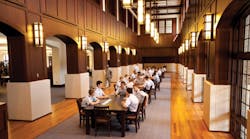Building, HVAC Controls Help Military School Keep Energy Costs in Line
Located on 206 acres in Gainesville, Ga., Riverside Military Academy includes dormitories, classrooms, an arts center, a dining hall, a library, a gymnasium, an Olympic-sized swimming pool, and lighted athletic fields. With annual utility bills approaching $1 million, the 100-percent-tuition-funded preparatory school was determined to reduce what was its second-largest expenditure.
The father of an alumnus and an active member of the school’s board of visitors, Danfoss consultant Robert Eidson took special interest in the school’s struggles with utility costs. Eidson worked with Facilities Director Larry Robinson to identify where energy was being used and formulate a plan to reduce consumption. The installation of a Danfoss AK-SC 255 system controller was critical to that plan.
“Riverside is now able to monitor individual buildings from any computer,” Eidson explained. “Because of this, when the academy goes through a variety of tasks, such as light-bulb changeout, adding variable-speed drives, or load shifting, they can view the direct results of our efforts though the Danfoss controller.”
The first step was identifying the school’s largest energy user: the barracks. Measures to reduce consumption included HVAC-system time-of-day settings and tighter room-temperature limit controls.
Using the system controller, Riverside detected another large energy consumer: the Olympic-sized swimming pool. The pool’s motor typically ran at full speed around the clock.
“Who is swimming at 2 a.m.?” Robinson asked. “Nobody. So why did we need to run that motor 24 hours a day seven days a week? We didn’t. We needed to have a certain amount of turnover in the pool water required for permitting purposes, but in all those downtimes, why couldn’t we ramp down that pump, save energy, and still keep our pool chemicals flowing like they should be?”
Riverside installed a Danfoss AKD-102 drive, which allows the motor to slow down and speed up. The motor slows down during the day, even when the pool is in use, and increases flow.
“I know that sounds counterproductive,” Robinson said, “but we lowered the head pressure and increased the volume. So, by slowing the motor down, we were able to cut the energy consumption of that motor, and at night, we slowed it down even more. Right now, we’re projecting energy savings as a direct result of the variable-speed-drive installation of nearly $11,000 annually.”
The system controller also identified outdoor lighting as a large consumer of energy.
“It was a nightmare,” Eidson said. “Every building had its own outdoor-lighting photocell. You’d drive onto the campus, and some buildings would have lights on, and some would have lights off. It was very inconsistent.”
Outdoor lighting was controlled with time clocks, which were expensive, costing nearly $300 each, and, often, unreliable, causing problems during power outages and daylight-saving time. Eidson recommended installation of a Danfoss light-level sensor, which works with each building’s outdoor lighting to maintain cohesive switch-on and switch-off. Switch-on and switch-off also can be set for specific times. This is particularly useful during Silver Taps, a prestigious ceremony calling for all lights to be shut off simultaneously for one hour.
“Before the Danfoss solution, you needed to have people in 12 different locations listening to a radio,” Eidson said.
“And if somebody wasn’t able to hear the signal or didn’t kill the lights on time, it was very noticeable,” Robinson added. “Now, it’s foolproof.”
The dining hall also was identified as a major energy consumer, as well as a contributor to high maintenance costs from the daily changeout of light bulbs in the 600-bulb ceiling. Riverside was able to realize savings through an $8,000 lighting upgrade, which included the installation of more than 300 LED lights. The bulbs helped to reduce not only energy use, but maintenance costs because of their longer life.
The dining-hall upgrade was funded by savings realized elsewhere on campus.
Since the installation of the system controller, variable-speed drive, energy meters, and lighting controls, Riverside has seen a 27-percent decrease in its annual energy consumption and a 5,817,654-kWh reduction over five years.
“What really got the ball rolling was the energy information,” Eidson said. “The data needed to be accurate and in a form people could understand. It needed to be understood by the electrician, facilities director, and maintenance professionals. The Danfoss system controller helped achieve this. Once these individuals were able to see the information, they were able to form a plan because they better understood how and where their facility was using energy.”
Added Robinson: “In fiscal year 2011-2012, our electricity expense was $416,000. This past year, we experienced increased enrollment, which required opening previously closed areas of the dorm. Taking this into account, along with a 26-percent increase in electricity rates, I still only budgeted $389,500 for our electricity expense. This reduced budget and the savings it represents is all a result of some of the proven changes we’ve been able to implement through a Danfoss solution.”
For Design Solutions author guidelines, call Scott Arnold, executive editor, at 216-931-9980, or write to him at [email protected].









